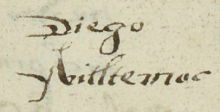Ihuitl Temoc (MH622r)
This black-line drawing of the compound glyph for a personal name, Ihuitl Temoc, shows a frontal view of a descending feather [ihuitl in a top-down position and a bird's eye view of two footprints, also descending. The latter, especially, suggests the verb temo, to descend (and in the past tense, with the -c at the end). [Note: Orozco y Berra (1880, v. 1, ch. 5) discusses some of the various uses of footprints, including temo and tleco. Zelia Nuttall (1888; 2008, p. 47) also mentioned the "multitude of meanings" of "footsteps." See our Bibliography for citations to these works.]
Stephanie Wood
There was a famous don Diego Luis Moctezuma Ihuitl Temoc (aka Ihuitemotzin). Perhaps this Mateo is named for don Diego or another illustrious person who shared this name.
Footprints are used as polyvalent hieroglyphs. As shown below, they can stand for temo, xo, quetza, or pano. Several of these are verbs, which suggests that feet help visually represent movement over--and an imprint upon--the landscape.
Stephanie Wood
1560
Jeff Haskett-Wood
plumas, huellas, icximachiyotl, xocpalli, icxipamitl, bajar, verbos, nombres de hombres

ihui(tl), feather, https://nahuatl.wired-humanities.org/content/ihuitl
temo, to descend, https://nahuatl.wired-humanities.org/content/temo
La Pluma Bajó
Stephanie Wood
Matrícula de Huexotzinco, folio 622r, World Digital Library, https://www.loc.gov/resource/gdcwdl.wdl_15282/?sp=326st=image.
This manuscript is hosted by the Library of Congress and the World Digital Library; used here with the Creative Commons, “Attribution-NonCommercial-ShareAlike 3.0 License” (CC-BY-NC-SAq 3.0).






